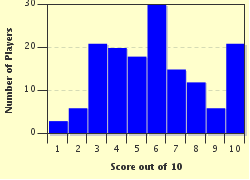Quiz Answer Key and Fun Facts
1. The Japanese believed in the divine origins of their land. Ruled by a god-emperor, the Tenno, it was a land watched over by the lesser gods and inhabited by a semi-divine chosen people. They saw death in the service of the Tenno as insufficient atonement for the debt they owed their homeland and regarded themselves as being charged with a divine mission. What was their manifest destiny?
2. The territories in eastern Asia contained all the raw materials that Japan would need to become self-sufficient and not be dependent on the white nations for her means of existence. Rubber and tin from Malaya, iron ore from the Philippines, rice from Indo-China, and oil, bauxite, coal, etc from the Indies. The events of 15 May 1940 brought within Japan's grasp the glittering prospect of securing these territories and their resources. What was the event?
3. Up until May 1940 the army had restrained the navy's desire for movement toward Southeast Asia. It had no wish to add further complications to an unfinished war and the sensitive uncertainties of Japanese-Soviet relations. With the defeat of France the army saw its chance to isolate China from outside support. What was the primary action to come out of the army-navy liaison meetings in June and July 1940?
4. Who was appointed to replace Admiral Mitsumasa Yonai in the new war cabinet?
5. With the fall of France, something close to real panic gripped the United States. Congress passed a series of measures designed to strengthen the American armed services, the most significant measure being the Two-Ocean Naval Expansion Act. The Imperial Navy appreciated that when the act's provisions were realized, the Americans would be so powerful at sea as to be unchallengable. When did Japan believe she would stand at the peak of her strength against the Americans?
6. Japan's strategy was the responsibility of the Imperial Government and the Naval General Staff but in fact one man came to dominate the strategic planning of the Imperial Navy in the two years before the Pearl Harbor operation. Who was it?
7. In the initial planning stages with Captain Genda, why did Admiral Yamamoto think that strikes on American battleships would be more effective than strikes on aircraft carriers?
8. The technical problems involved in the plan to attack Pearl Harbour were formidable, but most of them were soluble. Most of the problems centred around the torpedo, accepted by Genda as the primary means of attack. Japanese aerial torpedoes were designed to be dropped at about 250 feet and a speed of 150 knots before plunging to 14 fathoms. Unfortunately Pearl Harbor was only 8 fathoms deep. What was the main thing they did to solve this problem?
9. At an early stage in the planning Yamamoto selected an area in southern Kyushu as the training area for aircrews. The bay, with its restricted waters, volcanic island, and waterside buildings, bore a strong resemblance to Pearl Harbor. It was selected for precisely that reason. What was the name of this area?
10. On the 25th November Yamamoto, anticipating the failure of last-gasp diplomatic efforts to find a peaceful settlement with the Americans, ordered the carrier task force to sail on its mission the following day. The six carriers that sailed are well known, but which two battleships sailed with the fleet?
Source: Author
csm101
This quiz was reviewed by FunTrivia editor
bloomsby before going online.
Any errors found in FunTrivia content are routinely corrected through our feedback system.

